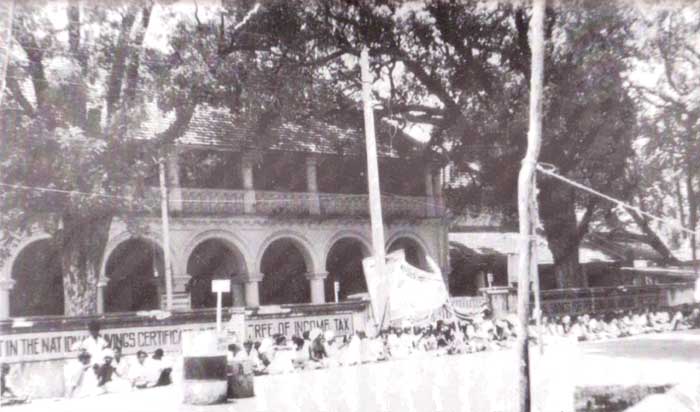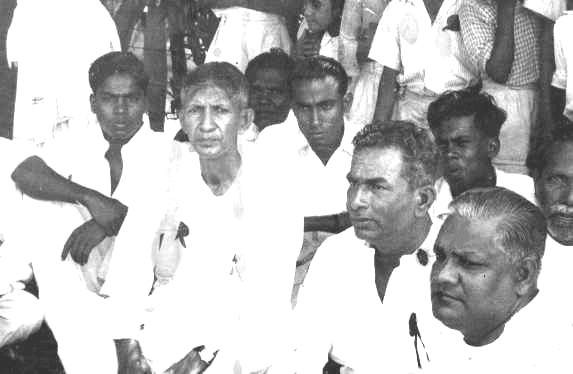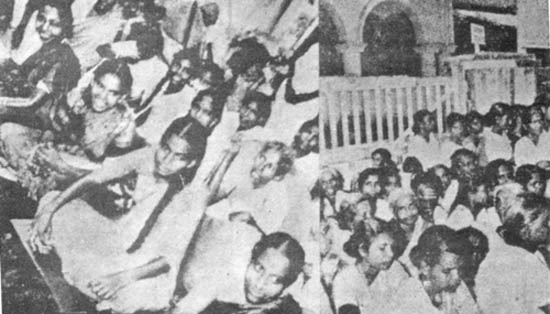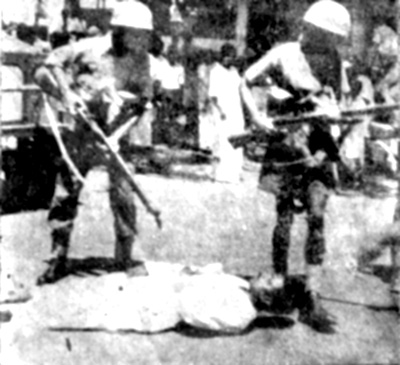|
  INDICTMENT AGAINST SRI LANKA INDICTMENT AGAINST SRI LANKA
The Charge is Ethnic Cleansing
SINHALA ARMY ATTACKS TAMIL
SATYAGRAHIS - 1961
"This is not a question of an army man here and
there, after liquor, indulging in excess (in 1961
against Tamils in Jaffna). No, there is some plan, some
purpose. There is an indication that they are going on
instructions and preparing for some trouble because the
purpose of the government in imposing an emergency and
allowing army and navy personnel to behave in that
fashion is to intimidate... the Tamil minority in this
country. That is the fact. That is the purpose."
Sinhala
Opposition Member of Parliament, Edmund
Samarakody, Hansard, 3 May 1961 on Prime Minister
Mrs.Srimavo Bandaranaike & the Sinhala Army in
Jaffna
|


Mr.S.J.V. Chelvanayakam
participating in a Satygaraha campaign in
Trincomalee in February 1961, with then
parliamentarians ( R-L) Mr. Thambiah Ehambaram (
Muttur MP), Mr.N.R.Rajavarothiam ( Trincomalee
MP).
|
|

Women Volunteers outside the
Gates of Old Jaffna Secretariat
|
"At no time did we underestimate the
might of the Prime Minister's (Srimavo Bandaranaike's)
government. We are quite aware that she has powers
enough to turn her armed forces against us. …The
Prime Minister has made a radio speech touching on
satyagraha. That speech is more benefiting an imperial
dictator speaking to her subjects than a speech made by
a democratic leader to her people. In fact the manner
and the contents of her speech correctly depict the
true status of the Tamil-speaking people in Ceylon. The
rule over them is indeed colonial imperialism. …
In her radio speech just before her departure to Great
Britain, she made an appeal to those whom she called
reasonable Tamils , "To disown the actions of the
mischief makers, namely the Federalists". … The
factual position is that there is no section of the
Tamil-speaking people, certainly in the northern and
eastern provinces, which does not fervently support the
satyagraha movement." S.J.V. Chelvanayakam,
4 March 1961.
From Sri
Lanka: Witness to History - A Journalist's Memoirs,
1930-2004 by S.Sivanayagam
"The satyagraha proper was limited to approved
volunteers of the party who were strictly forbidden
from any form of violence, either by word or deed, even
under the gravest provocation. But such was the
tremendous enthusiasm generated by this resistance
movement among all sections of the people, that it gave
the impression of a popular uprising, resulting in an
initial sharp reaction from the government. … The
police trampled on the satyagrahis with their boots,
pulled them by their hands and feet, lifted some of
them and hurled them away while attacking them with
batons. … [Enraged] by police violence [some]
hurled stones at the police jeeps and trucks. Thepolice
then used tear gas to disperse the crowd outside, which
fell back for a while, and kept surging forward again.
… The Kachcheri did not function. …
"On 21 February the satyagraha was led by the MP for
Vaddukoddai A. Amirthalingam: "Although the police were
present, armed with shields, batons and helmets, there
was a marked restraint in their behaviour. On the third
day, the police arrived at the secretariat at dawn and
took up positions trying to prevent volunteers from
blocking the entrances, but a party of 300 volunteers
… moved up despite the brandishing of batons and
half-hearted use of force. …
"[On the 23 February] women plunged into the movement.
Out of 500 satyagrahis led by the MP for Chavakachcheri
VN Navaratnam, about 80 women … took up positions
at the main entrance. … leading Muslims of Jaffna
decided to throw their weight with the movement.
…
"On the 24th the campaign spread to Mullaitivu, Mannar
and the Eastern province. On the 25th, a large
procession of Muslims led by Muslim lawyers and
businessmen joined the satyagrahis in Jaffna.
"On the 26th, Nominated MP and leader of the plantation
Tamils S. Thondaman warned against suppression of the
campaign and alerted plantation Tamils to store food
and provisions for three months should a struggle for
Tamil rights becomes necessary. …
"On the 27th satyagraha and picketing was launched in
Batticoloa and administration was brought to a halt
both in the North and East. On the 28th, an Opposition
suggestiong in the House of representatives that talks
be initiated with the Federal Party was summarily
rejected by Finance Minister Felix Dias
(Banadaranaike), saying that the government was not
prepared to negotiate under pressure. …
"[In the evening of 17 April] a special train carrying
a detachment of 350 soldiers and 15 officers of the
Sinha regiment, exclusively composed of Sinhalese, left
for Jaffna. … Once the MPs were taken away, army
men, some of them carrying rifles, swooped on the
passive satyagrahis, attacking them with rifle butts,
belts and clubs. The sleeping volunteers woke up
groaning and writhing with pain. They were trampled
with boots, kicked and dragged away from the kachcheri
entrances. … They pulled down the party's "post
office" structure, smashed up cars and bicycles parked
in the vicinity, ripping tyres with bayonets and
ramming windscreens. …
"On the 20th April, when the curfew was expired, a 12
hour curfew from 6 pm to 6 am was substituted.
…
"By April 24, Chelvanayakam and 58 others, including 14
MPs were under arrest … Jaffna came under virtual
army occupation. … Indisciplined , trigger-happy
soldiers shot dead and injured persons outside curfew
hours on the pretence of enforcing curfew."
|

|
| "Shoot if you must and I am
ready to die" the young student tells the soldier
who threatened him with death, if he did not move
away. Source - S.Ponniah, Satyagraha and The Freedom
Movement of The Tamils in Ceylon, 1963 |
Senator.S.
Nadesan,Q.C. Sri Lanka Senate Hansard, 2 May 1961
(full text)
"...The voice of the representatives of the Tamil
people has been virtually silenced. The military have
been let loose on the Northern and Eastern Provinces
and from all accounts are behaving - at any rate so far
as the Jaffna Peninsula is concerned - as if they were
a conquering army in occupation of enemy
territory....
(In) the early hours of the 18th (of April) the
military, without any warning and without informing the
satyagrahis assembled at the Jaffna Kachcheri that an
emergency had been declared, assaulted the men
satyagrahis mercilessly, bundled the women satyagrahis
into trucks and transported them. The military also
vented their wrath on a large number of push bicycles
and even on some motor cars parked at the Kachcheri
gates.
If the reports are true, the army seems to have
displayed considerable courage and valour in their
attacks on unarmed 'satyagrahis and on inanimate
objects like push bicycles! Certain Government
quarters, I am told, believe that the Ceylon Army had
covered itself with glory when, under the cover of
darkness and armed with modern weapons, it routed a
band of unarmed satyagrahis in what will go down in
history as the "Battle of Jaffna"!... Immediately the
"Battle of Jaffna" was over, the army proceeded to
waylay and hit all and sundry on t he roads of Jaffna
on the ground that they were breaking a curfew order,
of which most of them were unaware."
So far as the population outside these areas were
concerned, they were peaceful, non violent and
attending to their normal work. Instead of this being
done why was the army let loose on the entire
population of the Jaffna peninsula?
Why was a curfew imposed? Why have the military on
their own imposed a curfew even in villages where a
curfew had not been declared? Why are the farmers
of Jaffna who ordinarily go their fields in these hot
days at 4 a.m. in the morning prevented from doing so
till well after 6 a.m.? Why have the military been
beating and thrashing innocent passers by on the
streets of Jaffna?
Why have some of them been helping themselves to goods
and articles in shops and asking the owners to send the
bills to the Federal Party leader? Why have cars been
commandeered as if a great military campaign was afoot?
Why has petrol been issued on permits in Jaffna when
there is enough petrol for everybody? Why have the
military prevented people from having their lights on
at night?... Why have they set fire to fences and
madams and put the blame on the people?
Are these acts of organised terrorism and
lawlessness the result of any orders given to the army
to strike terror into the inhabitants of Jaffna so that
they might give up their agitation for their language
rights?
Today there is greater lawlessness in the Northern
and Eastern Provinces and particularly in the Jaffna
Peninsula than there has ever been at any time in its
recent history - lawlessness by the guardians of the
law...
If history teaches anything, it teaches us that
national movements thrive on terrorism and repression -
and the Ceylon army have by their conduct in the Jaffna
Peninsula given an added impetus for the movement of a
national minority to win its language rights. It must
also be noted that the true solution to the problem
facing Ceylon today cannot be found by resort to armed
force."
|